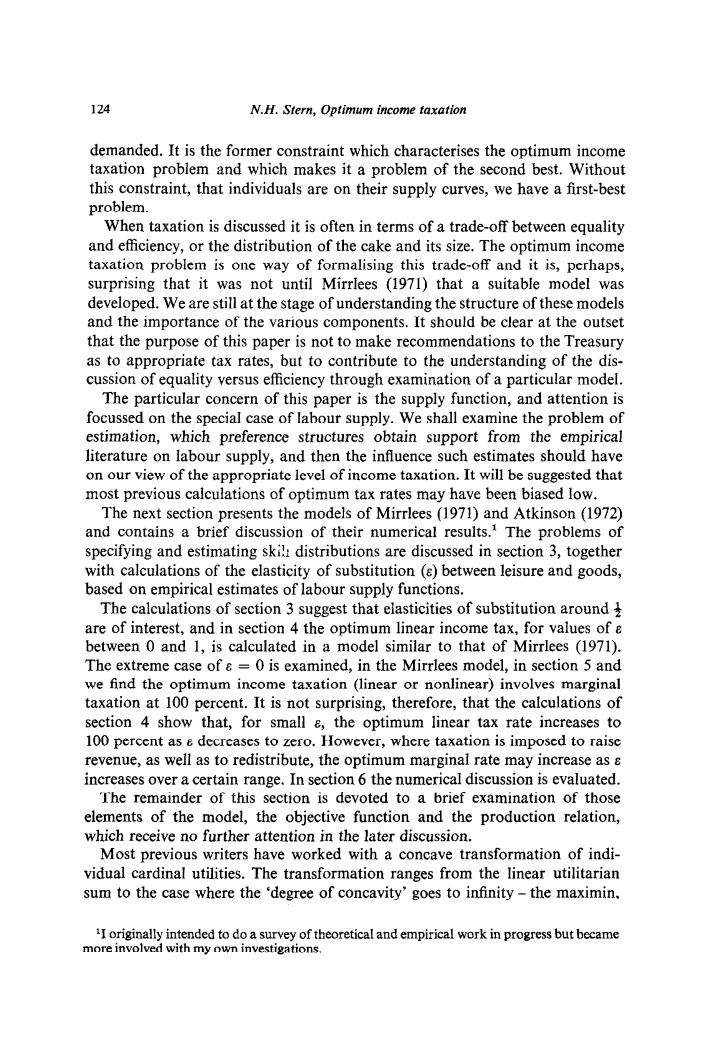正在加载图片...

名 N.H.Stern,Optimum income taxation demanded.It is the forme constraint which characterises the optimum income ation prob and which makes it a problem of the second best.Without this constraint,that individuals are on their supply curves,we have a first-best problem. When taxation is discussed it is often in terms of a trade-off between equality and efficiency,or the distribution of the cake and its size.The optimum income taxation problem is one way of formalising this trade-off and it is,perhaps g that it was not until Mirrlees (1971)that a suitable model wa We are stage of unders ture of these model and th t the the various co ponents.It should clear e outset that the purpose of this paper is not to make recommendations to the Treasury as to appropriate tax rates,but to contribute to the understanding of the dis cussion of equality versus efficiency through examination of a particular model. The particular concern of this paper is the supply function,and attention is focussed on the special case of labour supply.We shall examine the problem of estimation,which preference structures obtain support from the empirical literature on labour supply,a tes should h on o of th c level taxation. d tha most previous tax rates may have been b The next section presents the models of Mirrlees (1971)and Atkinson(1972) and contains a brief discussion of their numerical results.The problems of specifying and estimating ski!:distributions are discussed in section 3,together with calculations of the elasticity of substitution (e)between leisure and goods, based on empirical estimates of labour supply functions. The calculations of section 3 suggest that elasticities of substitution around o and and in s the ax,for m a odel。 Mirrlees (197 The e me case of0is examined,in the Mirrle mo in section 5 an we fin th optimum income taxation(linear or nonlinear)involves margina taxation at 100 percent.It is not surprising,therefore,that the calculations of section 4 show that,for small e,the optimum linear tax rate increases to 100 percent as s decreases to zero.However,where taxation is imposed to raisc revenue,as well as to redistribute,the optimum marginal rate may increase as e increases over a certain range.In section 6 the numerical discussion is evaluated. The rer ainder of this ection is devoted to a brief examination of those eler nte of the model,the obj ctive functio and the ion relation hich e no f ater discus ave worked with a concave transformation of indi- vidual cardinal.The transformation rangs from the linear utilitaran sum to the case where the 'degree of concavity'goes to infinity-the maximin, originally i more involved with my own investigations. retical and empirical work in p ess but became 124 N.H. Stern, Optimum income taxation demanded. It is the former constraint which characterises the optimum income taxation problem and which makes it a problem of the second best. Without this constraint, that individuals are on their supply curves, we have a first-best problem. When taxation is discussed it is often in terms of a trade-off between equality and efficiency, or the distribution of the cake and its size. The optimum income taxation problem is one way of formalising this trade-off and it is, perhaps, surprising that it was not until Mirrlees (1971) that a suitable model was developed. We are still at the stage of understanding the structure of these models and the importance of the various components. It should be clear at the outset that the purpose of this paper is not to make recommendations to the Treasury as to appropriate tax rates, but to contribute to the understanding of the discussion of equality versus efficiency through examination of a particular model. The particular concern of this paper is the supply function, and attention is focussed on the special case of labour supply. We shall examine the problem of estimation, which preference structures obtain support from the empirical literature on labour supply, and then the influence such estimates should have on our view of the appropriate level of income taxation. It will be suggested that most previous calculations of optimum tax rates may have been biased low. The next section presents the models of Mirrlees (1971) and Atkinson (1972) and contains a brief discussion of their numerical results.’ The problems of specifying and estimating ski!: distributions are discussed in section 3, together with calculations of the elasticity of substitution (E) between leisure and goods, based on empirical estimates of labour supply functions. The calculations of section 3 suggest that elasticities of substitution around 3 are of interest, and in section 4 the optimum linear income tax, for values of E between 0 and 1, is calculated in a model similar to that of Mirrlees (1971). The extreme case of E = 0 is examined, in the Mirrlees model, in section 5 and we find the optimum income taxation (linear or nonlinear) involves marginal taxation at 100 percent. It is not surprising, therefore, that the calculations of section 4 show that, for small E, the optimum linear tax rate increases to 100 percent as E decreases to zero. However, where taxation is imposed to raise revenue, as well as to redistribute, the optimum marginal rate may increase as E increases over a certain range. In section 6 the numerical discussion is evaluated. The remainder of this section is devoted to a brief examination of those elements of the model, the objective function and the production relation, which receive no further attention in the later discussion. Most previous writers have worked with a concave transformation of individual cardinal utilities. The transformation ranges from the linear utilitarian sum to the case where the ‘degree of concavity’ goes to infinity - the maximin, ‘1 originally intended to do a survey of theoretical and empirical work in progress but became more involved with my own investigations